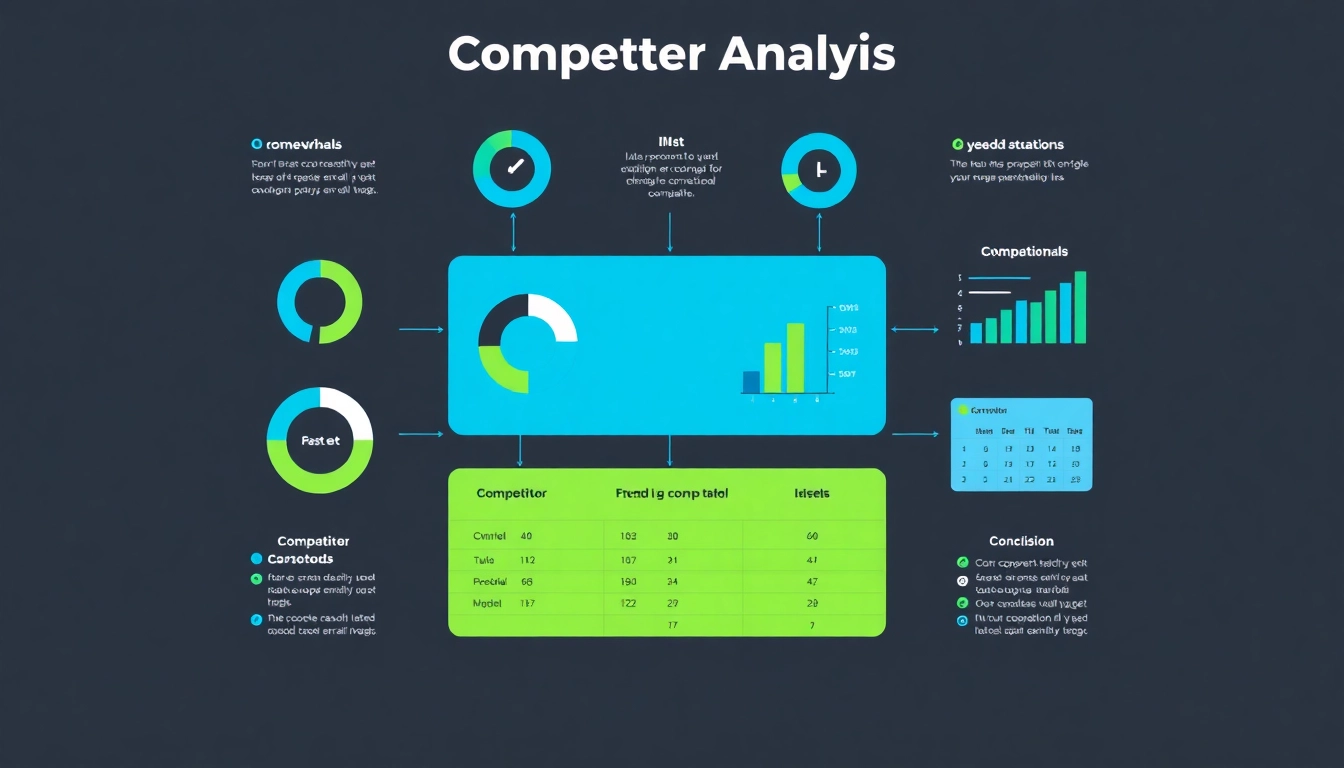Understanding Competitor Analysis
Defining Competitor Analysis
Competitor analysis, also referred to as competitive analysis, is the systematic process of examining similar brands within your industry to gain valuable insights into their offerings, branding strategies, sales methods, and marketing approaches. By understanding how competitors operate, businesses can evaluate their position in the market, identify their strengths and weaknesses, and recognize opportunities for growth and improvement. This strategic examination not only informs decision-making but also aids in defining a unique value proposition that distinguishes one brand from another. A well-executed competitor analysis can provide an essential roadmap for marketers and business owners alike.
The Importance of Competitor Analysis in Business
In today’s highly competitive marketplace, understanding the landscape in which your business operates is crucial. Competitor analysis helps organizations navigate their environments effectively. It offers several key benefits:
- Identifying Market Trends: Regularly analyzing competitors allows businesses to stay informed about market trends—in particular, shifts in consumer preferences and technological advancements that competitors are leveraging.
- Benchmarking Performance: By comparing sales figures, marketing strategies, and product features with those of competitors, businesses can set realistic performance benchmarks and strive for improvement.
- Uncovering Gaps in the Market: A thorough analysis can reveal underserved customer segments or unmet needs in the market, presenting opportunities to innovate or enhance offerings.
- Informed Decision-Making: The insights gained from competitor analysis empower businesses to make informed strategic decisions, whether it’s entering a new market, adapting pricing strategies, or launching a new product.
Types of Competitors: Direct vs Indirect
Understanding the various types of competitors is essential for effective analysis. Competitors can generally be categorized into two main types: direct and indirect.
- Direct Competitors: These are businesses offering similar products or services to the same target audience. For instance, if you own a coffee shop, other local coffee shops are your direct competitors.
- Indirect Competitors: These include businesses that provide alternative solutions or cater to different needs but ultimately compete for the same customer dollar. Continuing with the coffee shop example, tea shops or even convenience stores selling bottled coffee can be considered indirect competitors.
Key Components of a Successful Competitive Analysis
Market Research Techniques
Conducting market research is a critical first step in any competitive analysis. Several techniques can be employed to gather data about competitors:
- Surveys and Questionnaires: Collecting feedback directly from customers about existing products and services can yield valuable insights on competitors.
- Interviews: One-on-one discussions with industry stakeholders or customers can uncover perceptions about the competitors and market dynamics.
- Industry Reports: Utilizing publicly available resources and reports on industry performance can help highlight where competitors stand.
- Observation: Observing competitors through their marketing campaigns, social media, and customer interactions can provide insights into their strategies and performance.
SWOT Analysis for Competitors
SWOT analysis is an excellent framework for assessing a competitor’s strengths, weaknesses, opportunities, and threats:
- Strengths: What advantages does the competitor have? This could include brand recognition, customer loyalty, or superior technology.
- Weaknesses: What are their disadvantages? Identifying gaps in their products or service delivery can suggest opportunities for your business.
- Opportunities: Are there market trends that the competitor is not capitalizing on? Finding these gaps can help you position your offerings effectively.
- Threats: Consider external factors that might affect both your business and your competitors, such as regulatory changes or market saturation.
Evaluating Competitor Products and Services
Analyzing your competitors’ product and service offerings is crucial to understand how they meet customer needs. Assess the following aspects:
- Product Features: What features do competitors offer that set their products apart? Are there unique selling points that resonate with customers?
- Pricing Strategy: How do competitors price their products? Understanding their pricing strategy helps define your positioning.
- Customer Reviews and Feedback: Customer opinions can illuminate strengths and weaknesses in competitors’ offerings. Utilize platforms like Trustpilot, Yelp, and social media to gauge customer sentiment.
- Marketing Strategies: Examine how competitors promote their products. What channels do they use? Are there specific messages that resonate more with the audience?
Tools and Resources for Effective Competitor Analysis
Top Competitor Analysis Tools to Consider
Several tools can aid in the competitor analysis process, providing in-depth data and insights:
- SimilarWeb: This tool offers comprehensive insights into website traffic, engagement metrics, and user behavior trends for competitors.
- SEMrush: A powerful tool for competitive keyword analysis, SEMrush enables businesses to understand their competitors’ SEO strategies and PPC campaigns.
- Ahrefs: Similar to SEMrush, Ahrefs focuses on backlink analysis, providing insight into competitors’ SEO tactics.
- BuzzSumo: Ideal for content analysis, BuzzSumo helps identify the most shared content in your industry, showcasing what resonates with audiences.
Leveraging Data from Social Media Platforms
Social media is a treasure trove of competitive insights. By examining competitors’ social media activities, businesses can glean valuable information:
- Engagement Metrics: Analyzing likes, shares, and comments can gauge how well competitors connect with their audience.
- Content Strategy: Determine which types of content (videos, images, articles) are most effective for competitors.
- Audience Insights: Platforms like Facebook and Instagram provide demographic data that can help you understand your competitors’ audience.
Finding Relevant Market Reports
Market reports provide an overview of industry trends, growth forecasts, and key players. Some sources to consider include:
- Market Research Firms: Companies like Statista, IBISWorld, and Forrester Research specialize in detailed reports on various industries.
- Government Publications: Government agencies often publish economic reports, industry analyses, and market statistics.
- Academic Journals: Research articles can provide insights into emerging trends and methodologies that can impact the competitive landscape.
Steps to Conduct a Comprehensive Competitor Analysis
Step 1: Identifying Your Competition
The first step in conducting an effective competitor analysis is to identify who your competitors are:
- Real Competitors: Start with established businesses in your market that offer similar products or services.
- Perceived Competitors: Consider businesses that your target audience views as alternatives, even if they operate in different sectors.
- Market Research: Use tools such as Google Trends, SimilarWeb, and social media platforms to identify potential competitors.
Step 2: Gathering Data on Competitors
After identifying competitors, gathering relevant data is key:
- Perform Website Audits: Analyze competitors’ websites for user experience, content quality, and SEO effectiveness.
- Monitor Social Media: Keep an eye on competitors’ social media posts, interactions, and customer responses.
- Track Marketing Campaigns: Subscribe to competitors’ newsletters, follow their social media ads, and observe promotional strategies.
Step 3: Analyzing Competitor Strategies
Once you have gathered the data, it’s time to analyze it:
- SWOT Analysis: Use SWOT analysis frameworks to dissect competitors’ strategies effectively. Identify what works for them and where they may fall short.
- Trends and Patterns: Look for trends in how competitors communicate with their customers and the types of products they emphasize.
- Performance Metrics: Utilize tools like Google Analytics, SEMrush, or Ahrefs to examine competitors’ traffic, backlinks, and traffic sources.
Applying Insights from Competitor Analysis
Using Data to Inform Your Strategy
Data acquired from competitor analysis is only as valuable as the actions taken to apply it. Consider the following strategies:
- Tailored Marketing Campaigns: Use insights to create marketing messages and campaigns that resonate more strongly with your target audience.
- Innovative Product Development: Enhance existing products or introduce new offerings based on identified market gaps.
- Strategic Pricing: Adjust pricing strategies based on how competitors position their products concerning value and pricing.
Creating a Competitive Edge
Understanding your competitors enables you to create a sustainable competitive advantage:
- Differentiation: Focus on unique attributes that set your products or services apart from the competition.
- Customer Experience: Elevate the customer journey through exceptional service, user-friendly interfaces, and personalized communication.
- Brand Positioning: Position your brand to address specific customer pain points in ways that competitors do not.
Monitoring Competitors Regularly
Competitor analysis is not a one-time task but an ongoing necessity. Regularly monitoring your competitors can help keep your strategies fresh and relevant:
- Continual Evaluation: Schedule regular check-ins to assess updates in competitor strategies, product launches, and overall market changes.
- Adaptability: Be prepared to pivot your strategy based on evolving competitive dynamics and consumer preferences.
- Feedback Loops: Integrate feedback from customers on your offerings versus competitors to inform adjustments in your strategies.



